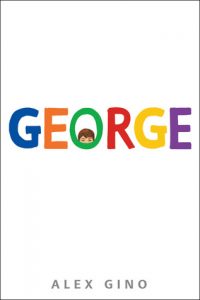 This year’s Freedom to Read week kicks off tomorrow, February 21, so let’s celebrate our freedom to read by exploring books that have been challenged or banned, contested in some way! Every year, Freedom to Read week and Banned Books Week (in the fall) roll around and we’re prompted to talk about why it’s important to have the freedom to access all sorts of different books, whether they agree with our point of view or not. We might think that banned or contested books would probably be extreme in their content, but in fact, most of us will definitely recognize one of consistently contested or banned books/series: Harry Potter. Yes, Harry has been being hunted down not just by Voldemort, but also by members of the general public. Apparently it’s been contested since the series came out, mostly for religious reasons – luring kids into practicing witchcraft! – but can you imagine a world where Harry Potter was successfully banned? Where we’d have had to as kids to exchange contraband Potter books in order to get our hands on the latest release, if at all? Actually, I can imagine that kind of world, especially since 2020 gave us, among other things, the national security law in Hong Kong, not to mention earlier this year, Hungary made LGBTQIA+ disclaimers mandatory on children’s books. So it’s a good time to pause and not take for granted our freedom to read.
This year’s Freedom to Read week kicks off tomorrow, February 21, so let’s celebrate our freedom to read by exploring books that have been challenged or banned, contested in some way! Every year, Freedom to Read week and Banned Books Week (in the fall) roll around and we’re prompted to talk about why it’s important to have the freedom to access all sorts of different books, whether they agree with our point of view or not. We might think that banned or contested books would probably be extreme in their content, but in fact, most of us will definitely recognize one of consistently contested or banned books/series: Harry Potter. Yes, Harry has been being hunted down not just by Voldemort, but also by members of the general public. Apparently it’s been contested since the series came out, mostly for religious reasons – luring kids into practicing witchcraft! – but can you imagine a world where Harry Potter was successfully banned? Where we’d have had to as kids to exchange contraband Potter books in order to get our hands on the latest release, if at all? Actually, I can imagine that kind of world, especially since 2020 gave us, among other things, the national security law in Hong Kong, not to mention earlier this year, Hungary made LGBTQIA+ disclaimers mandatory on children’s books. So it’s a good time to pause and not take for granted our freedom to read.
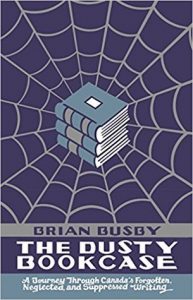 Just to start us off, here is the Canadian Charter of Rights and Freedoms “about” page. If you’re just interested in reviewing the charter, here it is. And here’s the guide to it, where if you ctrl+F and type in “hate”, you’ll find a non-legal-advice general statement about instances in which your freedom of expression might not be protected, for example “to protect other rights or important national values” (Canada.ca).
Just to start us off, here is the Canadian Charter of Rights and Freedoms “about” page. If you’re just interested in reviewing the charter, here it is. And here’s the guide to it, where if you ctrl+F and type in “hate”, you’ll find a non-legal-advice general statement about instances in which your freedom of expression might not be protected, for example “to protect other rights or important national values” (Canada.ca).
And in the spirit of transparency, here is a link to our Collection Development policy. You can also find Vaughan Public Libraries’ other policies on our website, under “About VPL” and then “Policies“. Just an FYI, though it’d be pretty ironic to receive more requests during Freedom to Read week just because I’m making it known: if you ever feel the need to contest something in our collection, whether it’s the fact that we have it at all or that you think it’s in the wrong collection, you can do so by reaching out to staff (LiveChat on our website, Email Librarian), who can send you a Request for Reconsideration form to fill out. Submitting the form does not automatically mean the item in question will be removed from our collection or immediately moved to the collection you think it belongs in, but it will begin the process of reconsideration for the title in question.
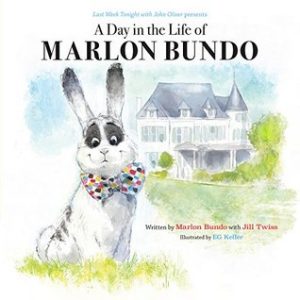 Speaking of titles that have been contested for being inappropriate for an age group, a recurring theme – just see Hungary – is that a lot of LGBTQIA+ content gets flagged as age-inappropriate. Take a look at the Top 10ish books/series that get the most challenges, by year, on the ALA website. Top of the list for 2019: George by Alex Gino (first cover image of this post). In fact, the first 6 titles were all challenged or banned for LGBTQIA+ content. Here is what George was banned or challenged for:
Speaking of titles that have been contested for being inappropriate for an age group, a recurring theme – just see Hungary – is that a lot of LGBTQIA+ content gets flagged as age-inappropriate. Take a look at the Top 10ish books/series that get the most challenges, by year, on the ALA website. Top of the list for 2019: George by Alex Gino (first cover image of this post). In fact, the first 6 titles were all challenged or banned for LGBTQIA+ content. Here is what George was banned or challenged for:
Reasons: challenged, banned, restricted, and hidden to avoid controversy; for LGBTQIA+ content and a transgender character; because schools and libraries should not “put books in a child’s hand that require discussion”; for sexual references; and for conflicting with a religious viewpoint and “traditional family structure”
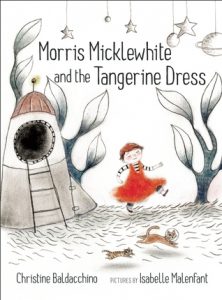 I’m sorry, “schools and libraries should not “put books in a child’s hand that require discussion””? What kind of books are schools and libraries supposed to be putting into the hands of children? And how old does “a child” go up till? What’s a good book that doesn’t inspire discussion? And that George conflicts “with a religious viewpoint and “traditional family structure”” are also just absolutely mind-blowing when taken as reasons for its being challenged. I understand this is the list for the U.S., so it might not make too much sense for me to cite the Canadian freedom of religion as protected by the Charter of Human Rights and Freedoms, but I’ll just go ahead and do that anyway. But even putting that aside, let’s tackle “traditional family structure” here a bit. Hate to break it to whoever needs to hear it, but those traditions are changing, and sticking our heads in the sand doesn’t really do much to change that.
I’m sorry, “schools and libraries should not “put books in a child’s hand that require discussion””? What kind of books are schools and libraries supposed to be putting into the hands of children? And how old does “a child” go up till? What’s a good book that doesn’t inspire discussion? And that George conflicts “with a religious viewpoint and “traditional family structure”” are also just absolutely mind-blowing when taken as reasons for its being challenged. I understand this is the list for the U.S., so it might not make too much sense for me to cite the Canadian freedom of religion as protected by the Charter of Human Rights and Freedoms, but I’ll just go ahead and do that anyway. But even putting that aside, let’s tackle “traditional family structure” here a bit. Hate to break it to whoever needs to hear it, but those traditions are changing, and sticking our heads in the sand doesn’t really do much to change that.
And when it comes to characters who don’t conform to that “traditional” mould, it’s just as illuminating considering why people are contesting the content, as Robert Bittner talks about in an article on the Freedom to Read webpage: “You’re Letting My Child Read What?!”. When the father in that article objects to his child being read Morris Micklewhite and the Tangerine Dress, what is he objecting to, really? If these are the discussions these titles inspire – require, even – then it’s all the more essential for them to continue to exist and be read and talked about.
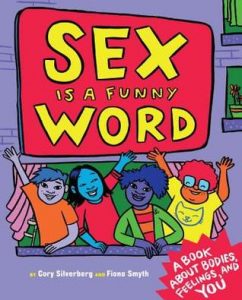 And I’ll just leave us off here with one last title from that Top 10 Banned/Contested list: Sex is a Funny Word by Cory Silverberg. Going by the reviews, it doesn’t even have very explicit information about sex as an act, rather talking about bodies, boundaries, feelings, gender, etc. According to the ALA website, its reasons for being challenged, banned, or relocated are because of its “LGBTQIA+ content; for discussing gender identity and sex education; and for concerns that the title and illustrations were “inappropriate””. But it’s not like refraining from talking about sex is a good way to prevent things like STIs, abuse, or pregnancy, as studies on abstinence-only sex ed have found time and time again.
And I’ll just leave us off here with one last title from that Top 10 Banned/Contested list: Sex is a Funny Word by Cory Silverberg. Going by the reviews, it doesn’t even have very explicit information about sex as an act, rather talking about bodies, boundaries, feelings, gender, etc. According to the ALA website, its reasons for being challenged, banned, or relocated are because of its “LGBTQIA+ content; for discussing gender identity and sex education; and for concerns that the title and illustrations were “inappropriate””. But it’s not like refraining from talking about sex is a good way to prevent things like STIs, abuse, or pregnancy, as studies on abstinence-only sex ed have found time and time again.
Erasing LGBTQIA+ characters and discussions; refusing to talk about sex; trying to uphold some status quo that is seen as “traditional” despite the fact that its accepted ubiquity before simply meant the oppression of people who didn’t fit into those moulds. How do these challenges and bans serve people who are represented by the works being challenged, and even those who aren’t represented in those works? I can’t help but feel like at their heart, these challenges are fueled by fear, whether that’s a fear of the unknown, fear of change, fear of losing one’s privileged position, that if too many people become accepted for who they are, perhaps the fear that one might have spent so much effort being someone they weren’t – and for what, if these other people can be accepted for being different (sunken cost fallacy)?
How will you be celebrating your freedom to read this week? Why not check out Freedom to Read publications from previous years, or read about the history of censorship in Canada (in literature and media)? Alternatively, marathoning the entire Harry Potter series all over again?
“How do these challenges and bans serve people who are represented by the works being challenged, and even those who aren’t represented in those works?” This question makes me sad, because the answer is the pro-ban crowd don’t WANT these people represented. All the more reason why we shouldn’t give hate/fear-based challenges any credence. They might be operating under the guise of “morality” (whatever that even means to this group) but they are, as you said, simply fearmongering.
When parents contest things like drug use or self-harm, I’m more inclined to by sympathetic. But the truth is sheltering kids does them no good. They’re gonna encounter them anyway! Having them engage in these issues safely is so beneficial. And I will say–the only time I’ve ever wanted to engage in censorship was when I saw young girls (like, preteen) checking out Fifty Shades of Grey (those books are the opposite of sex-positive). But truthfully it’s not my place! Just because I don’t like it doesn’t mean someone else won’t. And goodness knows the kind of stuff I was consuming at that age.
I also really like this point: “if too many people become accepted for who they are, perhaps the fear that one might have spent so much effort being someone they weren’t”. I never thought of that. Another very sad thought, similar to the people who argue against eliminating student debt because THEY had to pay it.